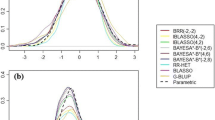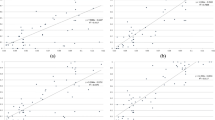Abstract
We present a multipoint algorithm for mapping quantitative trait loci (QTLs) using dominant markers. The algorithm is designed for outbred populations and is particularly suited for large families. The algorithm works with either codominant or dominant markers, either of which may be interspersed within the same linkage map. Concurrently, the algorithm also partitions dominance variance at the QTL. Computer simulations show that with large families, QTL mapping with dominant markers can be almost as powerful as with bi-allelic, codominant markers. Yet despite this, other situations show a large standard deviation in the estimate of the QTL position, thus making QTL mapping with dominant markers in outbred populations a useful detection tool, albeit limited in its resolution.
Similar content being viewed by others
References
Blackwelder, W.C. & R.C. Elston, 1982. Power and robustness of sib-pair linkage tests and extension to large sib-ships. Commun. Stat.: Theory Methods 11: 449–484.
Bradeen, J.M. & P.W. Simon, 1998. Conversion of an AFLP fragment linked to the carrot Y 2 locus to a simple, codominant, PCR-based marker form. Theor. Appl. Genet. 97: 960–967.
Churchill, G.A. & R.W. Doerge, 1994. Empirical threshold values for quantitative trait mapping. Genetics 138: 963–971.
Dolan, C.V., D.I. Boomsma, & M.C. Neale, 1999. A simulation study of the effects of assignment of prior identity-by-descent probabilities to unselected sib pairs, in covariance-structure modeling of a quantitative-trait locus. Am. J. Hum. Genet. 64: 268–280.
Elston, R.C., 1990. A general linkage method for the detection of major genes. pp. 495–506 in Advances in statistical methods for genetic improvement of livestock, edited by D. Gianola & K. Hammond. Springer-Verlag, Berlin.
Fulker D.W. & L.R. Cardon, 1994. A sib-pair approach to interval mapping of quantitative trait loci. Am. J. Hum. Genet. 54: 1092–1103.
Fulker D.W. & S.S. Cherny, 1996. An improved multipoint sib-pair analysis of quantitative traits. Behav. Genet. 26: 527–532.
Fulker D.W., S.S. Cherny, & L.R. Cardon, 1995. Multipoint interval mapping of quantitative trait loci, using sib pairs. Am. J. Hum. Genet. 56: 1224–1233.
Gessler, D.D.G. & S. Xu, 1996. Using the expectation or the distribution of the identity by descent for mapping quantitative trait loci under the random model. Am. J. Hum. Genet. 59: 1382–1390.
Haseman, J.K. & R.C. Elston, 1972. The investigation of linkage between a quantitative trait and a marker locus. Behav. Genet. 2: 3–19.
Hill, A.P., 1975. Quantitative linkage: a statistical procedure for its detection and estimation. Ann. Hum. Genet. 38: 439–449.
Jansen, R.C., 1996. A general Monte Carlo method for mapping multiple quantitative trait loci. Genetics 142: 305–311.
Jiang, C.J. & Z.B. Zeng, 1997. Mapping quantitative trait loci with dominant and missing markers in various crosses from two inbred lines. Genetica 101: 47–58.
Kruglyak, L. & E.S. Lander, 1995. Complete multipoint sib-pair analysis of qualitative and quantitative traits. Am. J. Hum. Genet. 57: 439–454.
Lander, E.S. & D. Botstein, 1989. Mapping Mendelian factors underlying quantitative traits using RFLP linkage maps. Genetics 121: 185–199.
Lander, E.S. & P. Green, 1987. Construction of multilocus genetic linkage maps in humans. Proc. Natl. Acad. Sci. USA 84: 2363–2367.
Lynch, M. & B. Walsh, 1998. Genetics and Analysis of Quantitative Traits. p. 516. Sinauer Assoc. Sunderland, MA.
Plomion, C., B.-H. Liu, & D.M. O'Malley, 1996. Genetic analysis using trans-dominant linked markers in an F 2 family. Theor. Appl. Genet. 93: 1083–1089.
Olson, J.M., 1995. Multipoint linkage analysis using sib pairs: an interval mapping approach for dichotomous outcomes. Am. J. Hum. Genet. 56: 788–798.
Wu, R.L., 1999 Mapping quantitative trait loci by genotyping haploid tissues. Genetics 152: 1741–1752.
Xu, S. & D.D.G. Gessler, 1998. Multipoint genetic mapping of quantitative trait loci using a variable number of sibs per family. Genet. Res. 71: 73–83.
Author information
Authors and Affiliations
Rights and permissions
About this article
Cite this article
Gessler, D.D.G., Xu, S. Multipoint genetic mapping of quantitative trait loci with dominant markers in outbred populations. Genetica 105, 281–291 (1999). https://doi.org/10.1023/A:1003981620837
Issue Date:
DOI: https://doi.org/10.1023/A:1003981620837




